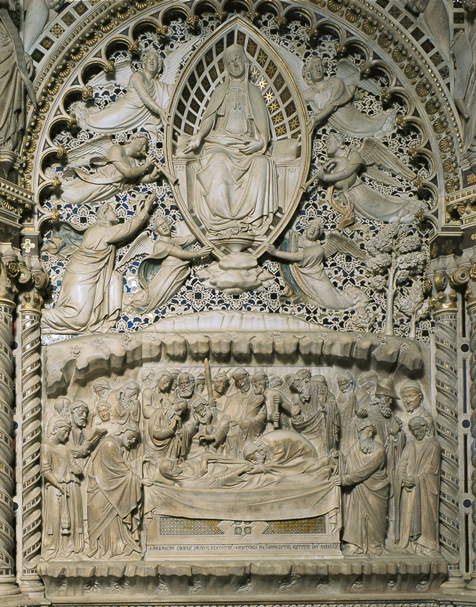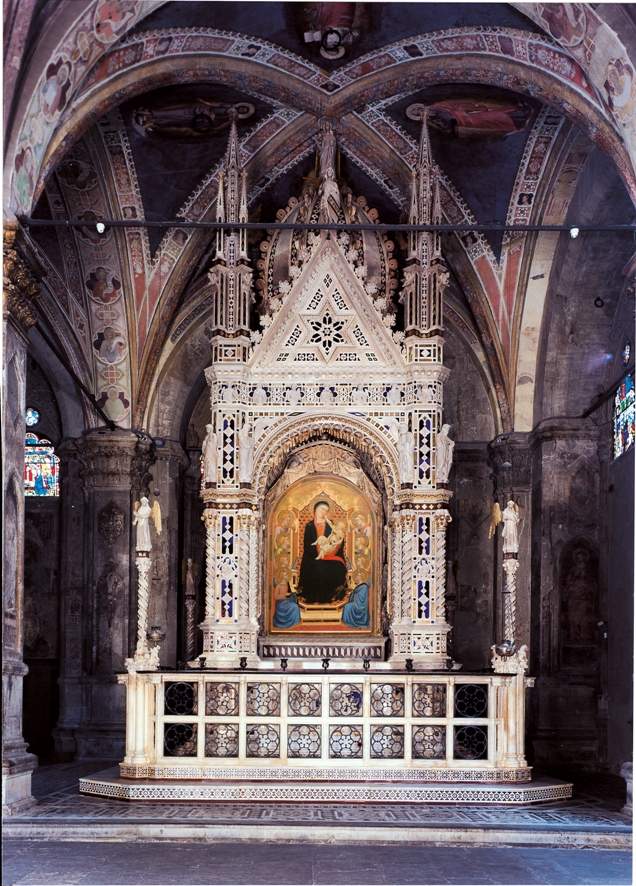Florence, Orcagna Tabernacle can finally be appreciated in its entirety
Until now, one of the great masterpieces of fourteenth-century Florence, the Tabernacle by Andrea di Cione known as l’Orcagna (Florence, c. 1310 - 1368), made for the church of Orsanmichele in Florence, could only be appreciated from one side, the front. As of yesterday, Saturday, December 8, 2018, the new access to the Tabernacle makes it possible to admire it also from its rear side, which until now was inaccessible: this is possible through a specially designed glass compass placed on the access door located on Via dei Calzaiuoli. The inauguration of the new access to the Orcagna Tab ernacle took place just yesterday in conjunction with the presentation of extraordinary maintenance of the Tabernacle.
Since its construction in 1359, the Tabernacle of Orsanmichele has represented one of the focal points of Florentine communal religiosity: an architectural construction updated on examples of very rich Gothic decoration, unusual in the city. A large scenic machine in white marble embellished with chromatic inserts: red of Cintoia and green of Prato, and deep blue glass or small colored and gilded geometric patterns. Originally the marble reliefs were also painted, as were the faux drapes suspended above the arches of the tabernacle and the architectural party were densely decorated on all sides in a triumph of colors, like contemporary goldwork, blazing in the light of oil lamps. The traces of this original design resurface at their best following the delicate dusting operation carried out on this occasion.
The monumental tabernacle was designed and made by Andrea di Cione known as l’Orcagna to house the gold-ground altarpiece with the Madonna of Graces by Bernardo Daddi (Borgo San Lorenzo, c. 1290 - Florence, 1348) and to protect it during the years when Orsamichele was also a grain market. The altarpiece is visible in the front part of the tabernacle, as are the reliefs in the lower band of the architectural structure illustrating the stories of Mary.
The great novelty presented on Saturday, December 8, is precisely the possibility of also admiring the back of this fascinating architectural construction, where the scene depicting Mary’s Death and Assumption into heaven, with the handing over of the Girdle to St. Thomas, can be seen. Also visible are those emblems of the Virgin, such as small roses, stars, or shell valves, that characterize all the rich marble decoration. In this part, moreover, Orcagna inscribed his signature and the date on which he completed the work: 1359. For more than a decade this part of the monument facing Via dei Calzaiuoli was inaccessible. Today, with the relocation of the ticket sales point at the Florence State Museums that prevented its view and its relocation inside the building, Florentines and visitors all will once again be able to appreciate its beauty with a wider and more complete perspective (pictured below, the back part of the tabernacle).
 |
The Church of Orsanmichele is one of the symbolic places of Florence also because, over the centuries, it has best represented its different souls: religious, political and economic. The restitution of the back of the Tabernacle to view, promoted by the Direction of the Bargello Museums (to which the Orsamichele Museum belongs), was an opportunity to bring together the different souls of today’s Florence in a great celebration that also involved exponents, from the city administration, civil and religious society. The event, which took place on the day of the celebration of the Immaculate Conception, was preceded at 3:30 p.m. by a concert by the Diocesan Institute for Sacred Music and continued at 4 p.m. with the blessing of the Tabernacle officiated by Cardinal Giuseppe Betori, archbishop of Florence. A presentation of the work carried out was then held, attended by Cardinal Betori, Paola D’Agostino (Director of the Bargello Museums), Giovanni Bettarini (Councillor for Urban Planning, Territorial Policies, Smart Cities, International Relations, and Local Development Cooperation of the City of Florence) and Eugenio Giani (President of the Friends of the Florentine Museums Association).
The maintenance of the Tabernacle, the restoration of an access point to the back of the monument and the inauguration of the new museum ticket sales point are part of a broader institutional agreement involving the state administration of cultural heritage (the Bargello Museums and the Territorial Superintendence), the Archiepiscopal Curia of Florence and the third sector (the Association of Friends of Florentine Museums), the first results of which were presented in the adjacent church of San Carlo (also on Via dei Calzaiuoli). In particular, they discussed the restoration and new display, right in the Church of San Carlo, of a rare 17th-century shaped and painted panel depicting St. Philip Neri as a boy adoring the Crucifix with St. Antoninus. Until the late 19th century the panel was in the church of Orsanmichele, placed under a wooden Crucifix attributed to Andrea Orcagna that justified the ecstatic gazes of the two figures. The Crucifix was later moved to San Carlo while the panel, which had flooded in the meantime, was placed in storage. The restoration, financed by the Bargello Museums, the Curia and the Friends of the Florentine Museums and supervised by the Soprintendenza, was presented by Monsignor Vasco Giuliani, Rector of the churches of Orsanmichele and San Carlo, by Jennifer Celani, Officer of the Soprintendenza Archeologia, Belle Arti Paesaggio for the metropolitan city of Florence and the provinces of Pistoia and Prato, and by Eugenio Giani.
Pictured: front view of the Orcagna Tabernacle.
 |
| Florence, Orcagna Tabernacle can finally be appreciated in its entirety |
Warning: the translation into English of the original Italian article was created using automatic tools. We undertake to review all articles, but we do not guarantee the total absence of inaccuracies in the translation due to the program. You can find the original by clicking on the ITA button. If you find any mistake,please contact us.




























